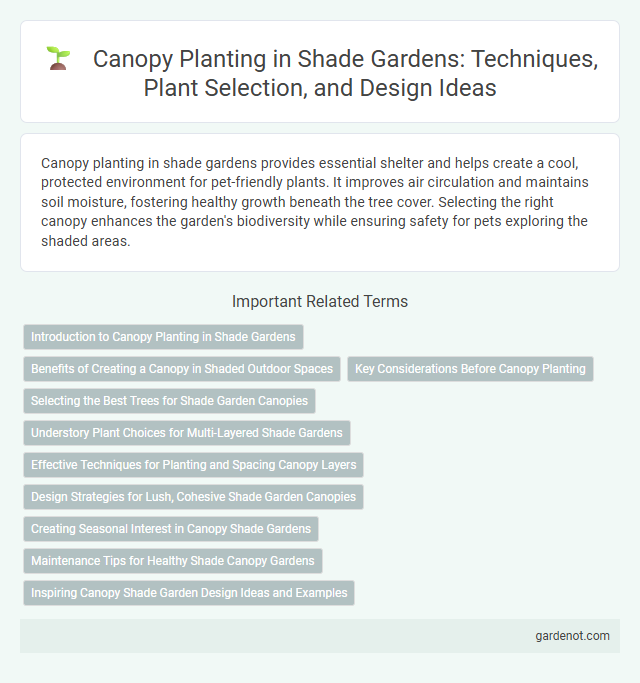Canopy planting in shade gardens provides essential shelter and helps create a cool, protected environment for pet-friendly plants. It improves air circulation and maintains soil moisture, fostering healthy growth beneath the tree cover. Selecting the right canopy enhances the garden's biodiversity while ensuring safety for pets exploring the shaded areas.
Introduction to Canopy Planting in Shade Gardens
Canopy planting in shade gardens involves selecting and positioning tall trees or shrubs to create a protective overhead layer that moderates sunlight and enhances microclimate conditions. This technique improves plant diversity by fostering ideal habitats for shade-loving perennials and ground covers, while also contributing to soil moisture retention and air quality. Common canopy species such as oak, maple, and beech are prized for their dense foliage and ability to support understorey vegetation.
Benefits of Creating a Canopy in Shaded Outdoor Spaces
Creating a canopy in shaded outdoor spaces enhances microclimate regulation by providing consistent filtration of sunlight, reducing temperature extremes and promoting plant diversity. Canopy planting supports soil moisture retention and erosion control, leading to healthier root systems and lower maintenance requirements. This structured shade environment encourages habitat creation for beneficial insects and birds, increasing biodiversity and ecological balance.
Key Considerations Before Canopy Planting
Proper soil analysis and selection of shade-tolerant tree species are critical key considerations before canopy planting in a shade garden. Ensuring adequate spacing between trees promotes healthy root expansion and prevents overcrowding, which can affect light penetration. Assessing long-term maintenance needs, such as pruning and watering schedules, supports sustainable canopy growth and overall garden health.
Selecting the Best Trees for Shade Garden Canopies
Selecting the best trees for shade garden canopies involves prioritizing species with broad, dense foliage that thrives in low-light conditions, such as Japanese maples, dogwoods, and redbuds. These trees provide optimal canopy coverage to protect understory plants while supporting local wildlife with their diverse habitats. Consider growth rate, mature size, and root system characteristics to ensure healthy integration into the shade garden environment.
Understory Plant Choices for Multi-Layered Shade Gardens
Understory plants such as hostas, ferns, and heucheras thrive in multi-layered shade gardens, providing texture and color beneath canopy trees like maples and oaks. These species adapt well to filtered sunlight, enhancing biodiversity and soil health through leaf litter and root interaction. Selecting diverse understory plants improves garden resilience against pests and varying light conditions.
Effective Techniques for Planting and Spacing Canopy Layers
Planting canopy layers in shade gardens requires careful consideration of tree and shrub species with varying growth heights and light requirements to maximize shade and understory plant health. Effective spacing involves maintaining adequate distances, typically 10 to 20 feet apart for small to medium trees, to promote air circulation and root development while preventing overcrowding. Incorporating layered vegetation such as taller canopy trees combined with mid-story shrubs ensures a diverse microclimate and optimizes overall garden resilience.
Design Strategies for Lush, Cohesive Shade Garden Canopies
Canopy planting in shade gardens involves selecting layered tree species with varying heights and foliage densities to create a multi-dimensional, lush canopy that maximizes shade coverage and visual interest. Incorporating native shade-tolerant plants like Japanese maples, dogwoods, and ferns enhances biodiversity and ensures long-term ecological balance. Strategic spacing and grouping promote healthier growth while fostering a cohesive, immersive environment that supports understory plants and wildlife habitats.
Creating Seasonal Interest in Canopy Shade Gardens
Canopy planting in shade gardens enhances seasonal interest by incorporating multi-layered trees and tall shrubs that provide dappled sunlight and dynamic textures year-round. Selecting species such as dogwoods, redbuds, and maples ensures vibrant spring blooms, lush summer foliage, and striking autumn colors, enriching the garden's visual appeal through changing seasons. The understory of ferns, hostas, and shade-tolerant perennials complements the canopy, creating a balanced ecosystem that thrives in partial to full shade conditions.
Maintenance Tips for Healthy Shade Canopy Gardens
Regular pruning of canopy trees promotes healthy growth and prevents overcrowding, ensuring optimal light penetration for understory plants. Applying organic mulch around tree bases helps retain soil moisture and suppresses weeds, reducing stress on shade-loving plants. Consistent monitoring for pests and diseases allows for early intervention, maintaining a vibrant and balanced shade garden ecosystem.
Inspiring Canopy Shade Garden Design Ideas and Examples
Canopy planting in shade gardens enhances microclimates by providing filtered light ideal for shade-loving plants such as hostas, ferns, and astilbes. Utilizing layered tree species like Japanese maples, dogwoods, and redbuds creates dynamic textures and seasonal interest, optimizing shade distribution and aesthetic appeal. Incorporating canopy elements with understory shrubs and groundcovers maximizes biodiversity while crafting tranquil, inviting outdoor spaces.
Canopy planting Infographic

 gardenot.com
gardenot.com